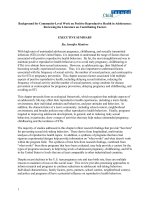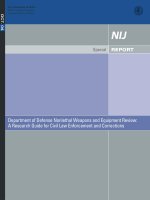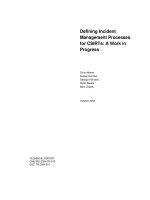env awareness for civil contruction work
Bạn đang xem bản rút gọn của tài liệu. Xem và tải ngay bản đầy đủ của tài liệu tại đây (2.23 MB, 62 trang )
WORKBOOK
ENVIRONMENTAL
AWARENESS
for civil construction projects
ENVIRONMENTAL AWARENESS FOR CIVIL CONSTRUCTION PROJECTS
PARTICIPANT WORKBOOK
ENVIRONMENTAL
AWARENESS
for civil construction projects
to
PARTICIPANT WORKBOOK
Environmental awareness for civil construction projects
Consultants for production of the workbook
Content
EnviroManagement Pty Ltd
PO Box 3329
Norwood SA 5067
Design
Open Cross
mobile 0419 862 393
© 2001
Transport SA
3337 Warwick Street
Walkerville SA 5081
ISBN 0 7590 0078 6
For further information about this document contact the
Environmental Operations Unit, Statewide Operational
Coordination Group, Transport SA. Telephone (08) 8343 2686
Transport SA thanks Jodie Gates for the photograph of rare
plant Cheiranthera volubilis.
Printed on paper which is 50% recycled and 50% oxygen bleached paper
ENVIRONMENTAL AWARENESS FOR CIVIL CONSTRUCTION PROJECTS
Contents
Section
Page
1. Introduction .................................................................................................................................... 1
2. Course aim and objectives ............................................................................................................. 2
3. Activities and environmental impacts .......................................................................................... 3
4. Obligations and legislative control ............................................................................................... 5
5. Environmental management for Transport SA construction projects ................................... 7
6. Vegetation management ............................................................................................................... 13
7. Fauna .............................................................................................................................................. 22
8. Erosion and sediment control .................................................................................................... 24
9. Watercourses and marine environments .................................................................................... 30
10. Heritage .......................................................................................................................................... 33
11. Noise and vibration ...................................................................................................................... 36
12. Air quality ...................................................................................................................................... 38
13. Waste management ....................................................................................................................... 40
14. Materials storage ........................................................................................................................... 43
Appendix A: References ..................................................................................................................... 47
Appendix B: Contact list .................................................................................................................... 48
Appendix C: Environmental terms .................................................................................................. 49
Appendix D: Summary of environmental legislation .................................................................... 52
.
PARTICIPANT WORKBOOK
ENVIRONMENTAL AWARENESS FOR CIVIL CONSTRUCTION PROJECTS
SECTION 1
Introduction
This workbook has been developed by Transport SA for
participants in the training course on Environmental awareness for
civil construction projects.
Transport SA is committed to developing a transport system in
harmony with the environment. To achieve this everyone
involved with the construction, operation and maintenance of the
transport system has a role to play in minimising environmental
impact and enhancing the environment.
The training of employees and contractors involved in
construction activities is a key to obtaining this goal.
This workbook and the companion Environmental Code of Practice
for ConstructionRoad, Bridge and Marine Facilities provide guidance
to environmental best practice.
The course has been developed and designed by:
Environmental Operations Unit
Statewide Operational Coordination
Transport SA
3337 Warwick Street Walkerville SA 5081
Telephone (08) 8343 2686
1
PARTICIPANT WORKBOOK
SECTION 2
Course aims and objectives
AIM OF THE COURSE
To provide construction workers with the knowledge to identify
environmental issues associated with their activities and best
practice methods to minimise environmental impact.
It will also outline environmental legal obligations relevant to
construction activities.
OBJECTIVES OF THE COURSE
At the completion of this course participants will be able to:
understand common environmental terms
state their legal obligations and responsibilities in relation to
environmental legislation
recognise common environmental impacts on construction
sites and potential impacts resulting from the individuals work
activities
identify accepted current environmental management best
practices for relevant workplace activities
identify situations which require further advice about
appropriate work practices to minimise environmental damage.
2
ENVIRONMENTAL AWARENESS FOR CIVIL CONSTRUCTION PROJECTS
SECTION 3
Activities and environmental impacts
To minimise environmental impact it is important to understand
the link between various construction activities and the potential
for these activities to impact on the environment. This section
gives a brief outline of typical activities and impacts.
The environment is defined as living things, their physical,
biological and social surroundings and the interactions between
all of these.
Environmental management measures will depend on the nature
of the site activities and the sensitivity of the project area and
surrounding land. For example, excavations resulting in steep
slopes are likely to lead to soil erosion and water quality problems
downstream and will require the installation of erosion protection
measures.
The workbook summarises legislative responsibilities and details
how environmental impact can be reduced by planning activities
carefully before commencing work on-site.
The table on the following page gives examples of common
construction activities and potential impacts. It is not a complete
listing.
3
Fire risk
Noise disturbance
Air emissions
Litter
Disturbance of sites of
natural or heritage significance
Habitat disturbance
Soil compaction
Soil erosion
Soil and water contamination
Interrupt or modify drainage
Spread of weeds
Damage to vegetation
V
e
ge
tat
i
E a on
c le
rt
h
a
wo
ra
nc
S
t
e
or r k s
ag
e
of
St
or
m
a
a
g
t
e
e
ria
of
ls
D
f
(
isp
ue
sto
l/
os
ck
o
a
i
p
l
lo
ile
G
f
s)
ra
w
d
in
as
g
te
Ro /co
m
a
d
pa
se
ct
ali
R
ng i n g
o
ad
m
ar
D
kin
ra
g
in
a
a
nd
g
Co e w
si
g
o
n
n
rk
cr
ag
s
e
e
t
Re e w
o
v
e
g e rks
tat
i
Activity
d
an
d
s
on
ds
lan
g
p
r
ay
in
W
ee
g
in
4
ca
p
Potential impact
PARTICIPANT WORKBOOK
ACTIVITIES AND ENVIRONMENTAL IMPACTS
Activities and environmental impacts
ENVIRONMENTAL AWARENESS FOR CIVIL CONSTRUCTION PROJECTS
SECTION 4
Obligations and legislative control
It is important that construction activities are undertaken in
accordance with environmental legislation.
Everyone on site is responsible for complying with
environmental legislation.
Under the Environment Protection Act 1993 everyone has a general
duty not to harm the environment by polluting.
Penalties for offences against environmental legislation are
significant.
The following legislation is relevant to aspects of construction
activities:
Aboriginal Heritage Act 1988
Agricultural Chemicals Act 1955
Animal and Plant Control Act 1986
Country Fires Act 1989
Coast Protection Act 1972
Dangerous Substances Act 1979
Development Act 1993
5
PARTICIPANT WORKBOOK
Environment Protection Act 1993
Environment Protection and Biodiversity Conservation Act 1999
(Commonwealth)
Heritage Act 1993
National Parks and Wildlife Act 1972
Native Vegetation Act 1991
Petroleum Products Regulations Act 1995
Pollution of Waters by Oil and Noxious Substances Act 1987
Soil Conservation and Land Care Act 1989
Water Resources Act 1997
Key aspects of the relevant environmental legislation are
considered in the following sections and a brief summary of the
legislation is included in Appendix D. However, if you are
uncertain about your obligations it is important that you seek
advice from your supervisor.
6
ENVIRONMENTAL AWARENESS FOR CIVIL CONSTRUCTION PROJECTS
SECTION 5
Environmental management
for Transport SA construction projects
Environmental management relates to the control of human
activity which could impact on the environment.
Construction of transport infrastructure can have significant
environmental impacts if not undertaken with care. An
environmental management system has been developed by
Transport SA to minimise the environmental impact of projects.
The system is outlined in the flow chart on the next page.
The construction site may also be licensed by the Environment
Protection Agency (EPA). The licence may include specific
conditions such as soil erosion controls, dust and noise monitoring.
For contractors the most important elements of the system are the
Environmental Management Implementation Plan (EMIP),
environmental inspection and monitoring.
The EMIP describes how the environmental management
requirements, identified in the Environmental Management Plan
(EMP), will be implemented and managed on site. The EMIP
details how the contractor will mitigate construction impacts and
documents the contractors plans for inspecting, monitoring,
auditing and correcting or improving environmental performance
on the site.
7
PARTICIPANT WORKBOOK
Not all projects require an EMIP. However, all projects are
required to comply with the Transport SA Environmental Code of
Practice for ConstructionRoad, Bridge and Marine Facilities and
legislative requirements.
It is important that you are aware of the elements within the
EMIP and the Code of Practice that are relevant to you.
An example of an EMIP schedule is included on page 10.
TRANSPORT SAS ENVIRONMENTAL MANAGEMENT SYSTEM
ORGANISA
TIONAL RESPONSIBILITY
ORGANISATIONAL
8
Project planning: assessment and
mitigation of environmental impacts
TRANSPOR
T SA
TRANSPORT
Environmental Management Plan (EMP)
and Environmental Code of PPractice
ractice
TRANSPOR
T SA
TRANSPORT
Environmental Management
Implementation Plan (EMIP)
CONTRA
CT
OR
CONTRACT
CTOR
Environmental inspection
and monitoring
CONTRA
CT
OR
CONTRACT
CTOR
Environmental auditing
TRANSPOR
T SA
TRANSPORT
ENVIRONMENTAL AWARENESS FOR CIVIL CONSTRUCTION PROJECTS
IMPORTANT STEPS TO REDUCE ENVIRONMENTAL IMPACTS
Walk the construction route to
identify the limit of vegetation
clearance, significant
vegetation, no go areas,
locations for stockpiles, plant
compounds and access
roads.
2.
Clearly identify the extent of
the construction area and
those areas to remain
undisturbed.
3.
Ensure machinery and
equipment are clean before
bringing to site.
4.
Keep work and vehicles within the construction area.
5.
Keep machinery and stockpiles on cleared areas
6.
Use the appropriate machinery for the task.
7.
Plan vegetation removal (do not clear vegetation unnecessarily).
8.
Topsoil should be stripped and stockpiled for use as soon as practicable.
9.
Protect and maintain site erosion control measures, such as:
replacing temporary cut-off drains at the end of the days work
minimise exposed soil and slopes
Illustration source: Wallbrink, S. & Stone, G. 1992, Roadside Handbook: Environmental guidelines for Road Construction & Maintenance Workers, Vic Roads, p.15.
1.
avoid damage to erosion control measures
replace damaged erosion control measures, including silt fences,
temporary bunds and straw bales
ensure the works drain to the erosion/sedimentation control structures.
10. Ensure waste is controlled and disposed of correctly.
11. Clean equipment before moving to another site.
12. If unsure about any environmental controls contact the site supervisor.
9
10
Hold point prior
to earthworks
commencing.
Physical inspection
against established
markers
Visual inspection
Construct sediment
detention basin prior
to construction
commencing and
divert flow from
construction site.
Maintain sediment
levels below 25%
Cut off drains to be
installed. Straw
bales, silt fences or
erosion matting to
be used to intercept
flow and stabilise
surfaces as required
Mulching of areas as Visual inspection
approved by contract
manager within 1
week of completion
Construction of
detention basin at
chainage 5001000m
and operating at a
minimum of 75%
capacity at all times
Protect cut and fill
areas from surface
runoff and stabilise as
soon as possible
Progressive mulching
of completed areas as
per construction
program
Inspection/test
Action
EMP measure
Inspect weekly
Inspect daily
between April
August and at other
times before and
after rain
Inspect weekly
between April
August and at
other times before
and after rain
Frequency
Nominated
areas mulched
Minimal
longitudinal
scour marks in
surface, minimal
sediment in
drains/pipes
Basin
constructed.
Sediment level
below 25% of
basin capacity
Acceptance
criteria
Site inspection and
entry in checklist
Site inspection &
entry in checklist.
Photos may be
taken.
Site inspection &
entry in checklist.
Site inspection &
entry in checklist
Evidence
Site
supervisor.
Site
supervisor.
Project
engineer. Site
supervisor.
Responsible
person
PARTICIPANT WORKBOOK
EXAMPLES OF THE TYPE OF MEASURES IN AN EMIP
Activities and environmental impacts
ENVIRONMENTAL AWARENESS FOR CIVIL CONSTRUCTION PROJECTS
ENVIRONMENTAL EMERGENCY RESPONSE
Soil contamination
resulting from
a washdown incident.
Many of the recommendations in this workbook will reduce the
risk of an environmental incident. However, there is always some
risk that an environmental incident may occur on the project site.
Examples of environmental incidents are:
significant spill of fuel or oil
significant chemical spill
severe erosion from flooding
fire (on site or from off site)
damage to a heritage site (Aboriginal or non-Aboriginal)
overflow from on-site washdown areas into creeks or drainage
lines
destruction of a rare plant outside the defined construction
zone.
It is important to be aware of site instruction(s) dealing with such
emergencies. Prompt and effective action is likely to significantly
reduce the environmental impact. Any such action should not
endanger the health or safety of any of the site workers.
An emergency response plan is an essential part of the
Environmental Management Implementation Plan. If you are
unaware of the emergency plan it is important to discuss it with
the site supervisor.
11
PARTICIPANT WORKBOOK
Some environmental incidents such as spillages and uncovering
of Aboriginal heritage sites require reporting to the appropriate
authorities. The site supervisor should be aware of these
requirements.
OPERATOR RESPONSIBILITIES
Ensure that you are aware of the site environmental emergency
response plan.
Locate emergency
OPERATOR RESPONSIBILITIES
FOR equipment that may be relevant to your
responsibilities.
Ensure that you are familiar with using emergency equipment that
is relevant to your responsibilities.
Ensure that you know whom to contact in the case of an
emergency.
Do not endanger the health and safety of yourself or others when
responding to an emergency situation.
12
ENVIRONMENTAL AWARENESS FOR CIVIL CONSTRUCTION PROJECTS
SECTION 6
Vegetation management
BACKGROUND INFORMATION
A construction site may contain vegetation that needs to be
protected. This may be urban street trees or remnant native
vegetation.
Vegetation has a range of benefits including:
biodiversitycontains a diverse range of plants and provides
habitat for animals and insects
soil stabilisationprotects soil from erosion, waterlogging
and salinisation
amenitybeautifies or enhances the character of an area
heritagemay be of historical importance or protected by
legislation.
Replacement of tree hollows to
provide shelter and breeding
locations for local wildlife.
Remnant native vegetation or naturally occurring local native
plants, include trees, small groundcovers, native grasses, wetland
plants (such as reeds and rushes) and marine plants. These plants
may be located in natural scrub or may be isolated plants in a
modified setting, such as urban street trees.
13
PARTICIPANT WORKBOOK
Native vegetation is valuable because it:
provides habitat for native wildlife
provides corridors to allow wildlife to move between patches
of habitat
may contain rare and endangered plants and animals
is easier to look after than introduced vegetation (eg suppresses
weed growth)
Native vegetation includes
(from left to right) grassland,
shrubland, forest and rare
species (bottom).
has a lower fire risk than weeds
provides a local seed source for revegetation
maintains the depth of the water table to prevent salinity
provides shade and shelter for adjacent farmland
improves the appearance of the landscape
reduces erosion.
Protecting vegetation involves more than protecting trees.
The smaller plants such as shrubs, grasses and herbs reduce
weeds, stabilise the soil and provide habitat for animals and
insects. The majority of South Australias threatened native
species are small shrubs, grasses and groundcovers. Native
vegetation will require little maintenance if undisturbed, and
regenerates after fire.
All vegetation plays an important role within the ecosystem.
Dead trees and trees with hollows are particularly valuable as
habitat for native animals and birds. Dead and decaying vegetation
release plant nutrients back into the soil. Aquatic vegetation
provides habitat for fish and other aquatic animals.
The re-establishment of vegetation on areas cleared or degraded
during construction is important.
14
ENVIRONMENTAL AWARENESS FOR CIVIL CONSTRUCTION PROJECTS
WORKING UNDER TREES
Soil compaction can be caused by
the weight of vehicles and
machinery, or when materials
are stockpiled on the
soil surface.
Healthy soil contains spaces holding air and water which are
essential for plant growth.
When soil is compacted, water and air can no longer travel
through the soil causing oxygen starvation for plant roots,
germinating seeds, and soil organisms. Soil compaction can also
result in restricting the spread of plant roots and poor soil
drainage.
Soil compaction can be caused by the weight of vehicles and
machinery, or when materials are stockpiled on the soil surface.
To reduce the effect of soil compaction:
keep vehicle movements to marked areas and defined access
tracks
use existing cleared land for
stockpiling
do not park machinery or
vehicles under tree canopies
(the drip-line).
15
PARTICIPANT WORKBOOK
SOME FACTS ABOUT WEEDS
A weed (pest plant) is a plant growing in the wrong place.
Proclaimed pest plants are weeds that have been declared to be a
serious threat to agriculture under the Animal and Plant Control Act
1986. Environmental weeds are weeds that threaten native plant
communities.
Weeds cause problems such as:
competition with agricultural plants
Disturbance of vegetation
can lead to weed invasion.
poisoning of livestock
increasing the roadside fire hazard
blocking waterways (eg table drains and culverts)
invading and displacing native vegetation.
Undisturbed native vegetation can generally resist weed invasion,
but disturbance (eg felling trees, driving over vegetation or actions
which expose the soil) will encourage weeds to become
established.
Spread of weeds
It is an offence to bring or let proclaimed pest plants to be
brought into certain control areas. It is also an offence to take a
pest plant or any soil or vehicle carrying a pest plant onto a public
road in a control area. To make sure that no pest plants or seeds
are transported in soil and vegetation caught on construction
vehicles, clean vehicles before moving out of a site or into a weed
free area.
Clean or wash down vehicles
to remove weed seeds.
When obtaining materials from borrow pits or stockpiles, check
that the material does not contain pest plants or their seeds. If
weeds have grown on stockpiles, they should be sprayed with
herbicide 10-14 days before moving the material.
Animal and Plant Control Boards
Advice on weeds in your site area can be obtained from the local
Animal and Plant Control Board. The local council can provide
details of the relevant board for the area in which you are
working.
16
ENVIRONMENTAL AWARENESS FOR CIVIL CONSTRUCTION PROJECTS
PLANT DISEASES
Phytophthora can easily be
spread by humans, so all
equipment used in an affected
area must be washed.
Phytophthora
Phytophthora cinnamoni is a root rot disease that occurs in high
rainfall areas. It causes the death of many of our native plants and
is a threat to many agricultural crops. Since plants take up
nutrients and water through their roots, root damage from this
fungus will affect the growth and survival of the plants.
Effects of phytophthora
Spread of the disease is mainly caused by human activities
including changing drainage patterns and movement of infected
soil on shoes, vehicles and machinery. The fungus spreads via soil
and water movement and will spread downhill along drainage
lines and creeks.
If plant diseases are present on your construction site, there will
be detailed hygiene instructions related to earthworks and vehicle
movements in the EMIP. Ensure that you are aware of any such
instructions.
Keep principles:
stay on formed areas or keep to defined access tracks
work in dry conditions and avoid low lying wet areas
Phytophthora hygiene kit
always clean down before leaving known infected areas.
17
PARTICIPANT WORKBOOK
AREAS AT RISK FROM PHYTOPHTHORA
18
ENVIRONMENTAL AWARENESS FOR CIVIL CONSTRUCTION PROJECTS
REVEGETATION
Revegetation of disturbed areas
assists in erosion control and in
minimising weed growth.
Revegetation of disturbed areas assists in erosion control and in
minimising weed growth.
Topsoil is important for plant growth and, in areas of native
vegetation, may be a significant seed source. Retaining and
reusing topsoil will assist in landscaping the project.
Grass cover and matting on
batter slope
When stripping topsoil maintain the soil layers in separate
stockpiles and replace them in the same order as they were
removed (the top 15 cm contains plant seeds, bulbs and soil
microorganisms).
Wherever possible, return topsoil and mulched vegetation to
approximately the same area from which it was removed.
Mulch and revegetation
19
PARTICIPANT WORKBOOK
OPERATOR RESPONSIBILITIES
Before working
Walk the job prior to starting any construction activities to ensure
that you understand the limits of the job and to identify the
location of any areas of vegetation to be protected.
OPERATOR RESPONSIBILITIES FOR
Ensure that vehicles and equipment are free from soil, weeds and
seeds before coming on site.
Take note if your site is subject to plant disease control measures.
Check for areas, which may have been marked by bunting to
protect vegetation.
Check with your supervisor if you are unsure about anything.
During the work
Minimise vegetation disturbance and protect all vegetation not
identified for removal.
Avoid the use of machinery or vehicles outside the construction
zone. Use designated parking areas and plant compounds.
Locate stockpiles and their access in cleared areas, away from
drainage lines or good vegetation.
Maintain bunting around protected areas.
Store weed infested materials separately from clean materials.
Clear or spray weeds before stockpiling topsoil.
Check fill and construction materials for weeds and seeds before
use.
Control weeds from stockpiles 1014 days before use. If material
is weed infested, inform the supervisor.
Revegetate or mulch disturbed areas, particularly batter slopes, at
the earliest opportunity.
Do not flush spray bars near vegetation or under the tree canopy.
Do not stockpile material on vegetation, under tree canopies or
against trunks.
Do not burn vegetation prunings or removals unless there are no
other options and keep fires clear of other vegetation.
20









